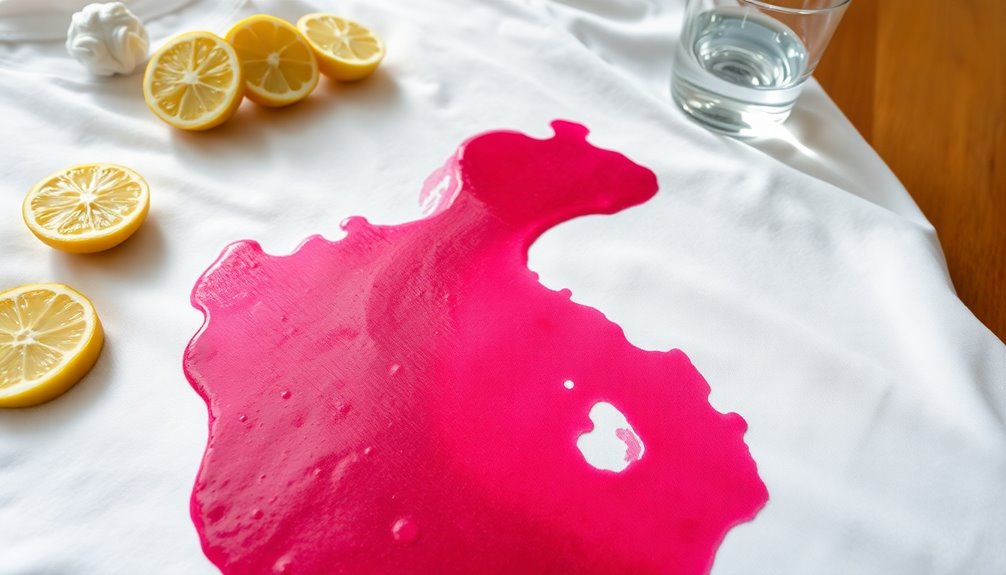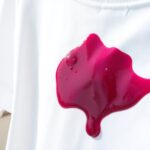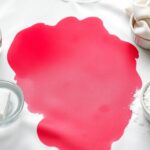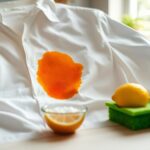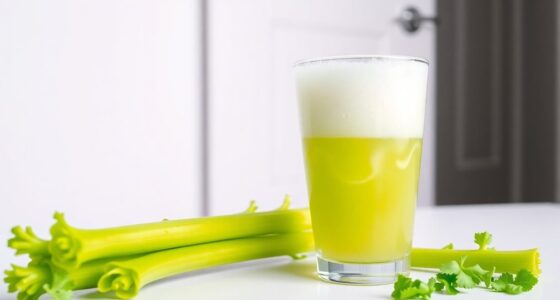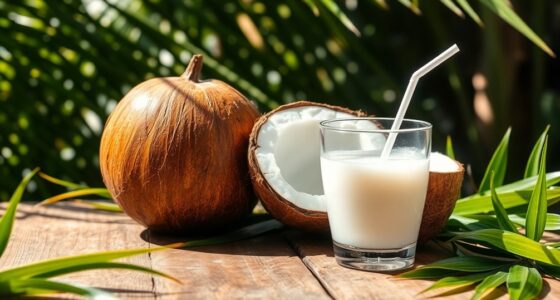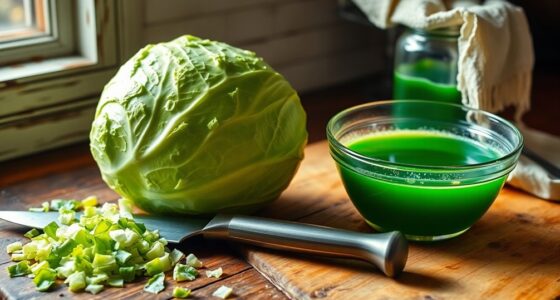To get beet juice out of clothes, act quickly! Start by scraping off excess residue and rinsing the stain under cold water, using the reverse side of the fabric if possible. If it's still there, mix one tablespoon of dish soap with a cup of cold water and apply it to the stain for 15 minutes. Rinse again, and if needed, soak with an oxygen bleach solution. Keep going—there's more to learn about removing tough stains!
Key Takeaways
- Act quickly to rinse the stained area under cold water, using the reverse side of the fabric to push out the beet juice.
- Mix one tablespoon of dish soap with a cup of cold water, apply it to the stain, and let it sit for at least 15 minutes.
- If the stain persists, soak the garment in an oxygen bleach solution for about eight hours after testing for colorfastness.
- Rinse the garment thoroughly with cold water after using any cleaning solution to remove all beet juice residue.
- Check for remaining stains before drying; avoid heat if traces remain, and repeat the cleaning process if necessary.
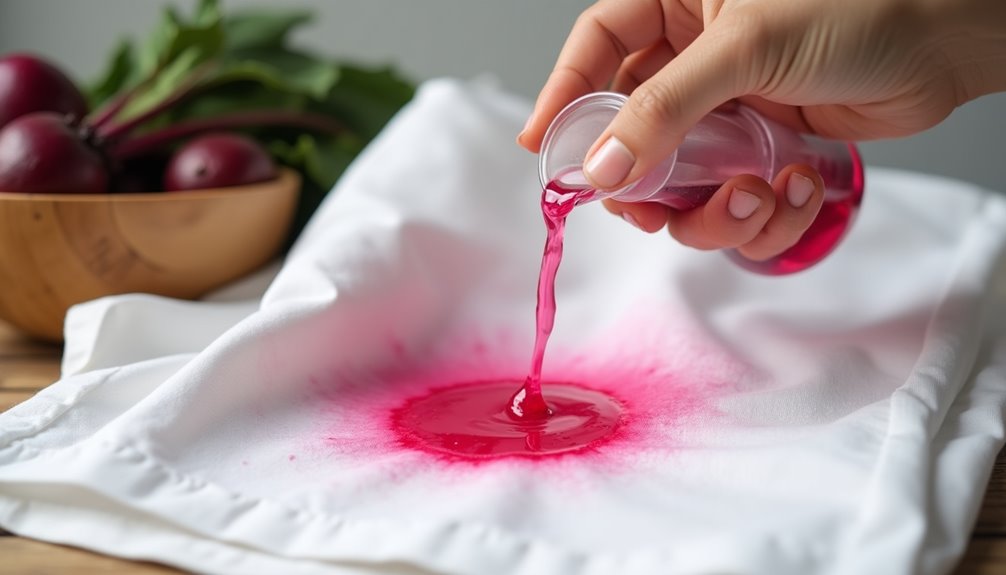
Beet juice stains can be a real hassle, but with the right approach, you can get your clothes looking good as new. When you find yourself dealing with this vibrant, stubborn stain, it's essential to act quickly. The longer you let the stain set, the harder it becomes to remove.
Start by gently scraping off any excess beet residue using a dull knife. Be careful not to damage the fabric while doing this; you just want to lift away any bits of beet without pushing the stain deeper into the garment.
Once you've removed the excess, it's time to rinse the stained area under cold running water. Make sure to run the water from the reverse side of the fabric, as this helps push out the pigment instead of driving it further in. Cold water is key here; hot water could set the stain, making it even more challenging to remove.
After rinsing, assess the stain. If it's still visible, you'll need to treat it with a stain remover solution.
Mix one tablespoon of dish soap with a cup of cold water to create a simple yet effective cleaning solution. Apply this mixture directly to the stain and allow it to sit for at least 15 minutes. This waiting period is crucial, as it gives the dish soap time to break down the beet pigment.
After the time's up, rinse the area again under cold running water. You might see the stain lifting; if not, don't lose hope just yet.
If traces of the beet stain remain, it's time to escalate your efforts by soaking the garment in an oxygen bleach solution. Mix according to the instructions on the bleach package, and remember to test the solution on an inconspicuous area first to ensure the fabric is colorfast.
Soak the stained garment for about eight hours. This method is highly effective for stubborn stains, but it's essential not to skip the testing step, as some fabrics may react unpredictably.
After soaking, rinse the garment thoroughly with cold water again. Before you throw it in the dryer, check carefully for any remaining stains. If you spot any, avoid heat, as it can set the stain permanently.
Instead, repeat the cleaning process if necessary. You might find that a little persistence pays off, and soon you'll have your once beet-stained clothes looking fresh and clean.
Frequently Asked Questions
How Do You Get Beetroot Juice Out of Fabric?
To tackle beetroot juice stains on fabric, you'll want to act quickly.
Start by scraping off any excess with a dull knife. Rinse the stained area under cold water from the back to push out the pigment.
Next, pre-treat the stain with a mix of dish soap and cold water, letting it sit for about 15 minutes.
If it's still there, soak the fabric in oxygen-based bleach and cool water for eight hours.
Does Beetroot Wash Out of Clothes?
Imagine trying to wash away a sunset's vibrant hues from a canvas; beetroot stains can feel just as stubborn.
But yes, beetroot can wash out of clothes! If you act quickly, rinsing with cold water and using the right stain removers makes a big difference.
Cotton's your best friend here, while delicate fabrics need extra care. Soak or pre-treat those stains, and you might just reclaim your favorite shirt!
What Is the Best Stain Remover for Beetroot Stains?
The best stain remover for beetroot stains is typically an enzyme-based product that targets the pigments in beets.
You can also try a DIY solution by mixing one tablespoon of dish soap with one cup of cold water to dab the stain before rinsing.
For a natural approach, lemon juice or vinegar works well due to their acidity.
If the stains are stubborn, oxygen-based bleach can be effective when used as directed.
Always test first!
Do Beet Juice Stains Come Out?
Did you know that over 30% of people struggle with stubborn stains like beet juice?
When it comes to beet juice stains, they can come out if you act quickly. Rinse the fabric with cold water immediately to prevent the stain from setting.
Using an enzyme-based stain remover or a simple mix of dish soap and cold water boosts your chances of success.
Just remember, don't use hot water, or you'll make it worse!
Conclusion
In conclusion, banishing beet juice stains doesn't have to be a burden. By acting quickly and following simple steps, you can save your shirt from stubborn spots. Soak, scrub, and sun-dry for a stain-free success! Remember, with a little patience and persistence, you can transform your troubled threads into tidy treasures. Don't let those pesky pigments ruin your day—embrace the challenge and enjoy the satisfaction of a spotless solution!
Cindy thoroughly researches juicing trends, techniques, and recipes to provide readers with practical advice and inspiration. Her writing style is accessible, engaging, and designed to make complex concepts easy to understand. Cindy’s dedication to promoting the advantages of juicing shines through her work, empowering readers to make positive changes in their lives through the simple act of juicing.

